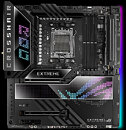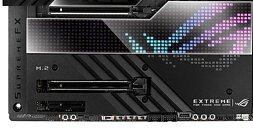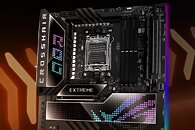TheLostSwede
News Editor
- Joined
- Nov 11, 2004
- Messages
- 18,400 (2.47/day)
- Location
- Sweden
| System Name | Overlord Mk MLI |
|---|---|
| Processor | AMD Ryzen 7 7800X3D |
| Motherboard | Gigabyte X670E Aorus Master |
| Cooling | Noctua NH-D15 SE with offsets |
| Memory | 32GB Team T-Create Expert DDR5 6000 MHz @ CL30-34-34-68 |
| Video Card(s) | Gainward GeForce RTX 4080 Phantom GS |
| Storage | 1TB Solidigm P44 Pro, 2 TB Corsair MP600 Pro, 2TB Kingston KC3000 |
| Display(s) | Acer XV272K LVbmiipruzx 4K@160Hz |
| Case | Fractal Design Torrent Compact |
| Audio Device(s) | Corsair Virtuoso SE |
| Power Supply | be quiet! Pure Power 12 M 850 W |
| Mouse | Logitech G502 Lightspeed |
| Keyboard | Corsair K70 Max |
| Software | Windows 10 Pro |
| Benchmark Scores | https://valid.x86.fr/yfsd9w |
Although AMD didn't provide too many details during its Computex 2022 keynote speech about the upcoming AM5 platform, the company did announce that there will be at least three chipsets for the platform and showed pictures of some upcoming motherboards. ASUS has kindly filled in some more details about its upcoming ROG Crosshair X670E Extreme, which will be one of its higher-end models. Sadly the pictures posted are kind of tiny and the company didn't provide a shot of the rear I/O. That said, ASUS did point out some of its new features that we can expect to find on the ROG Crosshair X670E Extreme.
For starters, the board will have a pair of PCIe 5.0 x16 slots, although each slot is likely to only have eight lanes each, when both slots are in use, but ASUS doesn't mention any details here. The board has support for up to five M.2 NVMe SSDs, four of which support PCIe 5.0. Only two are onboard, with the other three being via ASUS' proprietary ROG PCIe 5.0 M.2 card and ROG GEN-Z.2 card. ASUS also promises USB4 support, as well as a USB 3.2 Gen 2x2 header with Quick Charge 4+ as well as up to 60 W charging support, for cases with a front USB-C port. On top of the rear I/O is an AniMe Matrix LED display that can be user customised.





ASUS has gone for a 20+2 "teamed power stage" that is rated for 110 A, which should hopefully give plenty of headroom for AMD's upcoming 170 W TDP CPUs, especially as AMD announced that the X670E chipset was for extreme overclocking. ASUS has carried over its Q-Release button for the graphics card from its Z690 boards, as well as its Q-Latch for M.2 SSDs. The board will also have a Q-Code debug LED display and a Q-LED diagnostics LED array. On the top of LEDs, ASUS has also installed multiple ARGB headers on the board.
Other features include a Marvell AQtion 10 Gbps Ethernet controller, an Intel 2.5 Gbps Ethernet controller and WiFi 6E support. ASUS has also updated its SupremeFX audio solution with an ESS ES9218PQ Quad DAC setup that delivers a 130 dB signal-to-noise ratio. The board also has six SATA ports and what appears to be all right-angled connectors, including the power connector. Other things not mentioned is a PCIe x4 slot of unknown PCIe revision, a set of switches and buttons along the bottom of the board that are normally related to overclocking, as well as what appears to be a power and reset CMOS button at the top of the board.
View at TechPowerUp Main Site | Source
For starters, the board will have a pair of PCIe 5.0 x16 slots, although each slot is likely to only have eight lanes each, when both slots are in use, but ASUS doesn't mention any details here. The board has support for up to five M.2 NVMe SSDs, four of which support PCIe 5.0. Only two are onboard, with the other three being via ASUS' proprietary ROG PCIe 5.0 M.2 card and ROG GEN-Z.2 card. ASUS also promises USB4 support, as well as a USB 3.2 Gen 2x2 header with Quick Charge 4+ as well as up to 60 W charging support, for cases with a front USB-C port. On top of the rear I/O is an AniMe Matrix LED display that can be user customised.





ASUS has gone for a 20+2 "teamed power stage" that is rated for 110 A, which should hopefully give plenty of headroom for AMD's upcoming 170 W TDP CPUs, especially as AMD announced that the X670E chipset was for extreme overclocking. ASUS has carried over its Q-Release button for the graphics card from its Z690 boards, as well as its Q-Latch for M.2 SSDs. The board will also have a Q-Code debug LED display and a Q-LED diagnostics LED array. On the top of LEDs, ASUS has also installed multiple ARGB headers on the board.
Other features include a Marvell AQtion 10 Gbps Ethernet controller, an Intel 2.5 Gbps Ethernet controller and WiFi 6E support. ASUS has also updated its SupremeFX audio solution with an ESS ES9218PQ Quad DAC setup that delivers a 130 dB signal-to-noise ratio. The board also has six SATA ports and what appears to be all right-angled connectors, including the power connector. Other things not mentioned is a PCIe x4 slot of unknown PCIe revision, a set of switches and buttons along the bottom of the board that are normally related to overclocking, as well as what appears to be a power and reset CMOS button at the top of the board.
View at TechPowerUp Main Site | Source




